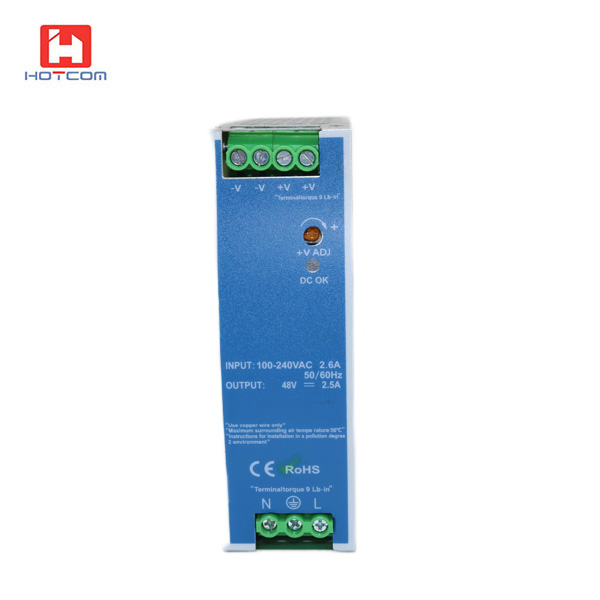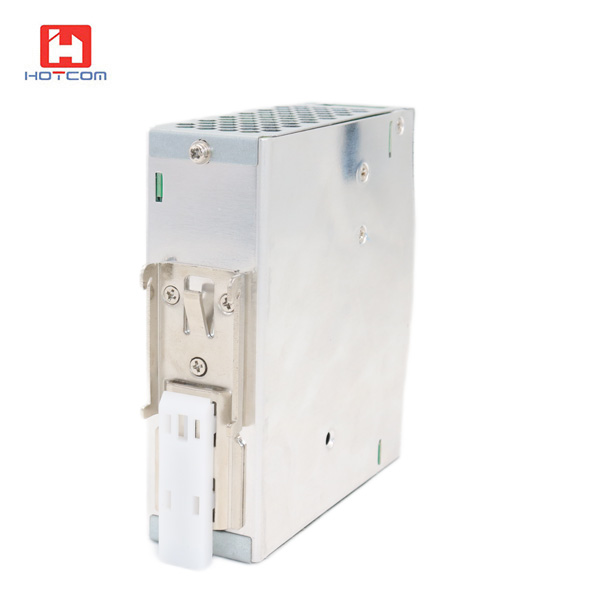|
SPECIFICATIONS
|
|
|
OUTPUT
|
|
|
Model
|
HT-DR-120-12
|
HT-DR-120-24
|
HT-DR-120-48
|
|
DC Voltage
|
12V
|
24V
|
48V
|
|
Rated Current
|
10A
|
5A
|
2.5A
|
|
Current Range
|
0-10A
|
0-5A
|
0-2.5A
|
|
Rated Power
|
120W
|
120W
|
120W
|
|
Ripple & Noise
|
80mVp-p
|
80mVp-p
|
100mVp-p
|
|
Voltage Adj. Range
|
12-14V
|
24-28V
|
48-53V
|
|
Voltage Tolerance
|
±2%
|
±1%
|
±1%
|
|
Line regulation
|
±0.5%
|
±0.5%
|
±0.5%
|
|
Load regulation
|
±1%
|
±1%
|
±1%
|
|
Setup, Rise Time
|
500ms,70ms/230VAC 500ms,70ms/115VAC at full load
|
|
Hold Up Time
|
36ms/230VAC 32ms/115VAC at full load
|
|
|
|
|
INPUT
|
|
|
Voltage Range
|
88~132VAC/176~264VAC selected by switch 47~63Hz; 248~370VDC
|
|
AC Current
|
2.6A/115VAC 1.6A/230VAC
|
|
Efficiency
|
80%
|
84%
|
85%
|
|
Inrush Current
|
Cold start 20A/115V 40A/230V
|
|
Leakage Current
|
<3.5mA/240VAC
|
|
|
|
|
PROTECTION
|
|
|
Over Load
|
105%~150% rated output power
|
|
Protection type: Constant current limiting, recovers automatically after fault condition is removed
|
|
Over Voltage
|
15-16.5V
|
29-33V
|
58-65V
|
|
Protection type: Shut down o/p voltage, re-power on to recover
|
|
Over Temp.
|
85℃±5℃(TSW1)
|
90℃±5℃(TSW1)
|
90℃±5℃(TSW1)
|
|
Protection type: Shut down o/p voltage, recovers automatically after temperature goes down
|
|
|
|
|
ENVIRONMENT
|
|
|
Working Temp., Humidity
|
-10℃~+60℃; 20%~90% RH non-condensing
|
|
Storage Temp., Humidity
|
-20℃~+85℃; 10%~95%RH
|
|
Vibration
|
10~500Hz, 2G 10min./1cycle, period for 60min, each along X, Y, Z axes
|
|
|
|
|
SAFETY
|
|
|
Withstand Voltage
|
I/P-O/P: 3KVAC I/P-FG: 1.5KVAC O/P-FG: 0.5KVAC
|
|
Isolation Resistance
|
I/P-O/P, I/P-FG, O/P-FG: 100M Ohms / 500VDC/25℃/70%RH
|
|
|
|
|
STANDARD
|
|
|
Safety Standard
|
Design refer to UL508,UL60950-1,TUV EN60950-1
|
|
EMC Standard
|
Design refer to EN55011,EN55022,EN61000-3-2,-3,EN61000-4-2,3,4,5,6,8,11,EN55024,EN61000-6-2(EN50082-2), heavy industry level, criteria A
|
|
|
|
|
OTHERS
|
|
|
Dimension
|
65.5*125.2*100mm(L*W*H)
|
|
Weight
|
0.79Kg
|
|
Packing
|
20pcs/carton/16.5kg/1.29CUFT
|




